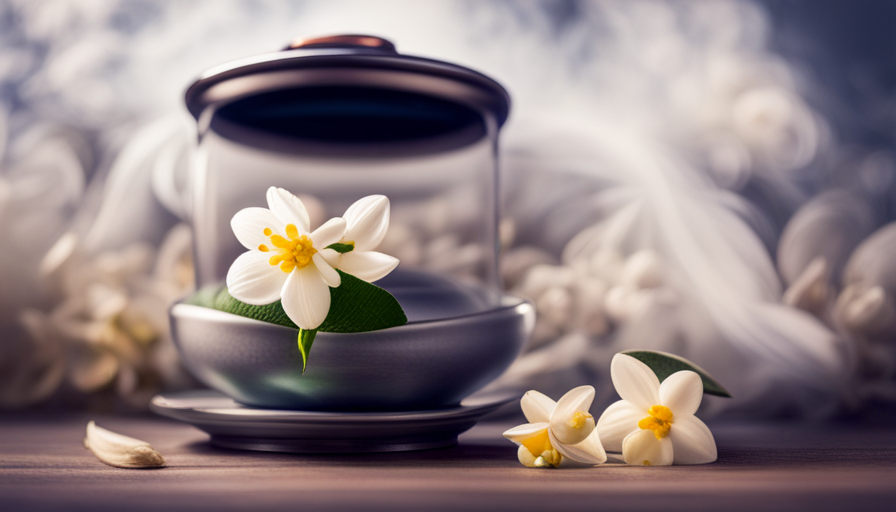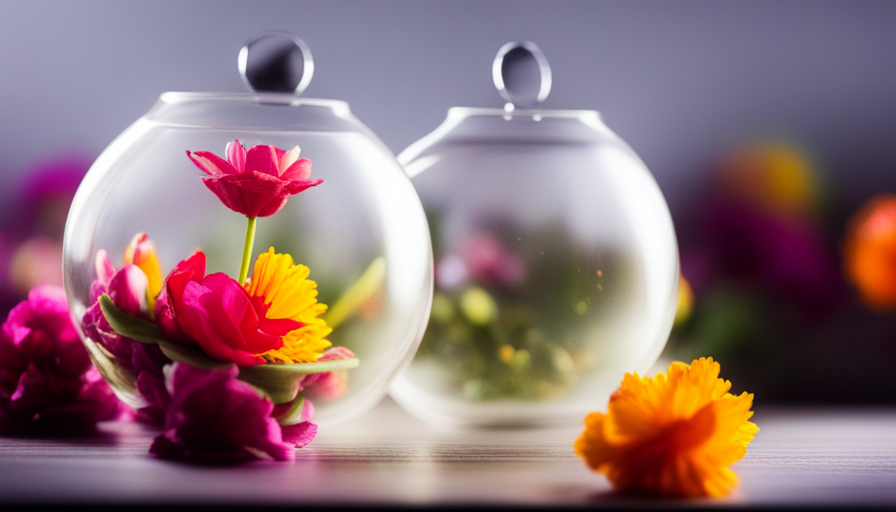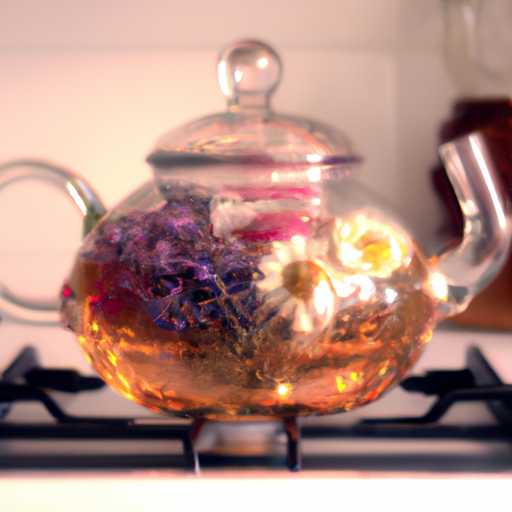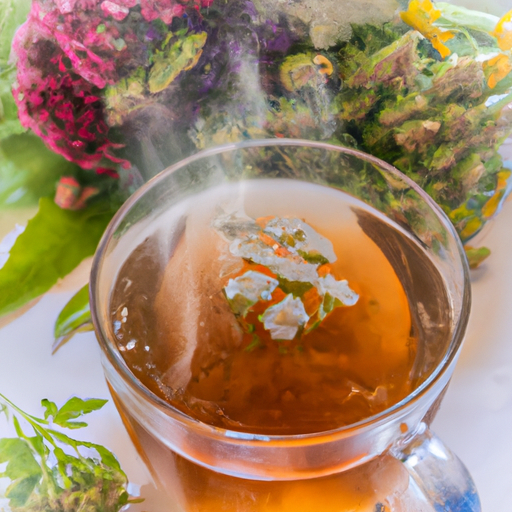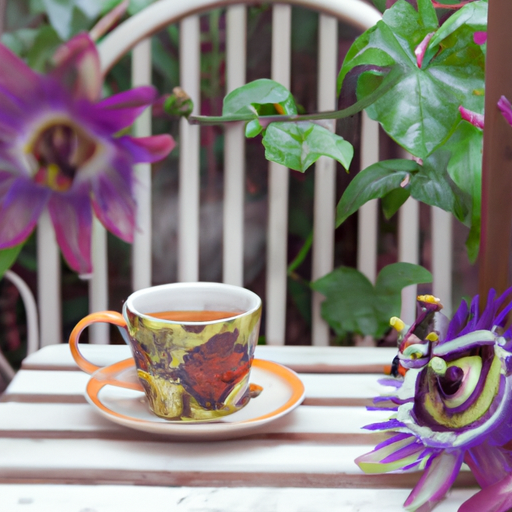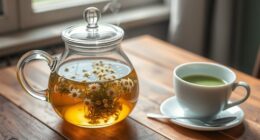I understand that you may feel like making tea from jasmine flowers is a complex and lengthy task. However, I assure you that the final product is well worth the time and effort. There is a truly enchanting quality to the gentle scent and delightful flavor of jasmine flower tea that can sweep you away to a serene and peaceful state.
In this article, I will guide you through the steps of making your own jasmine flower tea, from gathering and preparing the fresh flowers to brewing methods and enhancing the flavor. I’ll also share tips on storing and preserving jasmine flowers, as well as exploring variations of this delightful tea.
Jasmine flower tea is not just a beverage, it’s an experience. The benefits of jasmine flowers go beyond their captivating scent – they are known to have calming and stress-relieving properties.
So why not take a moment for yourself, indulge in the art of steeping jasmine flower tea, and savor the beauty and serenity it brings to your day?
Let’s dive in and unlock the secrets of making tea from jasmine flowers.
Key Takeaways
- Jasmine flower tea has a rewarding process, magical aroma, and exquisite taste.
- It has calming and stress-relieving properties and is rich in antioxidants, reducing the risk of chronic diseases.
- Different types of jasmine tea have unique benefits, such as green tea for metabolism and weight loss and white tea for skin health.
- To make jasmine flower tea, choose fully bloomed flowers with a strong fragrance and use dried jasmine petals if fresh flowers are not available.
The Benefits of Jasmine Flower Tea
You’re going to love the amazing benefits that jasmine flower tea can bring to your health and well-being! Drinking jasmine tea has a multitude of benefits that can improve both your physical and mental health.
One of the main benefits of drinking jasmine tea is its ability to reduce stress and anxiety. The soothing aroma of jasmine flowers can promote a sense of calmness and relaxation, helping you to unwind after a long day.
Additionally, jasmine tea is known for its antioxidant properties, which can help to protect your body against free radicals and reduce the risk of chronic diseases.
There are also different types of jasmine tea that you can choose from, each with its own unique set of benefits. Jasmine green tea, for example, is a popular choice due to its high concentration of antioxidants and its ability to boost metabolism and aid in weight loss.
Jasmine white tea, on the other hand, is known for its delicate flavor and its ability to improve skin health and promote a youthful complexion.
Now that you know the benefits of drinking jasmine tea, let’s move on to the next step of gathering and preparing fresh jasmine flowers.
Gathering and Preparing Fresh Jasmine Flowers
When it comes to gathering and preparing fresh jasmine flowers for tea, there are a few key points to keep in mind. First, it’s important to choose the right flowers, making sure they’re fully bloomed and have a strong fragrance.
Next, cleaning the flowers is essential to remove any dirt or impurities. Finally, drying the flowers thoroughly ensures they retain their flavor and aroma.
By following these steps, you can enjoy a cup of jasmine flower tea that’s both fragrant and delicious.
Choosing the right flowers
To ensure a fragrant and flavorful tea, it’s crucial to select the perfect jasmine flowers for brewing. Here are some tips for choosing the right flowers:
-
Select fresh blooms: Look for flowers that are fully open and have a vibrant white color. These blooms are at their peak and will provide the best flavor.
-
Use dried petals: If fresh flowers aren’t available, dried jasmine petals can also be used. Make sure they’re stored in an airtight container to retain their aroma.
By carefully selecting the flowers, you can guarantee a delightful tea experience.
Now, let’s move on to the next step of the process: cleaning and drying the flowers to preserve their essence.
Cleaning and drying the flowers
Properly maintaining the freshness of the blooms is essential for preserving the delicate essence of the jasmine flowers. To ensure the best quality tea, it is crucial to clean and dry the flowers carefully. Cleaning techniques involve gently rinsing the flowers under cool running water to remove any dirt or impurities. It is important to handle the flowers with care to prevent damage. After cleaning, the flowers should be spread out on a clean, dry surface to air dry. Avoid direct sunlight or excessive heat, as it can affect the aroma and flavor of the flowers. Patience is key during the drying process, as it may take several days for the flowers to completely dry. Once the flowers are dried, they are ready to be used in brewing methods for jasmine flower tea.
Brewing Methods for Jasmine Flower Tea
When it comes to brewing jasmine flower tea, there are three main methods that I highly recommend trying.
The first is hot brewing, where you steep the jasmine flowers in hot water for a few minutes to release their aromatic flavors.
The second is cold brewing, which involves steeping the flowers in cold water overnight for a refreshing and delicate taste.
Lastly, you can also experiment with infusing the jasmine flowers with other teas like green tea or oolong tea for a unique and flavorful blend.
No matter which method you choose, brewing jasmine flower tea is a delightful experience that’ll awaken your senses and leave you craving more.
Hot brewing
Steep the jasmine flowers in hot water to infuse the tea with their delicate aroma and flavors, creating a soothing and fragrant beverage. Hot brewing is a traditional method that brings out the full essence of the jasmine flowers. To make jasmine flower tea, you’ll need to heat water to a specific temperature and allow the flowers to steep for a certain amount of time. The ideal brewing temperature for jasmine flower tea is around 175°F (80°C). This temperature allows the fragrance and flavor of the flowers to release gently into the water. Steep the flowers for about 3-5 minutes to achieve a balanced and flavorful brew. The longer you steep, the stronger the flavor will be. After the steeping time, strain the tea to remove the flowers and enjoy the aromatic, soothing tea. Moving on to cold brewing, a different method that brings out a unique flavor profile.
Cold brewing
After exploring the art of hot brewing jasmine flower tea, let’s delve into the refreshing world of cold brewing. Cold brewing techniques unlock a whole new dimension of flavors and aromas in jasmine tea. It involves steeping the jasmine flowers in cold water for an extended period, allowing the delicate flavors to infuse slowly.
Cold brewed jasmine flower tea is not only a treat for the senses but also offers numerous health benefits. The longer steeping time extracts less caffeine and more antioxidants, making it a perfect choice for those seeking a gentle pick-me-up. Additionally, the floral notes are beautifully accentuated, creating a soothing and calming effect.
Now that we’ve mastered the art of cold brewing, let’s move on to the next exciting step: infusing jasmine flower tea with other teas to create delightful blends.
Infusing with other teas
Combining different teas with jasmine flower tea creates a delightful blend that enhances the flavors and aromas. By infusing jasmine flower tea with other teas, you can create unique and exciting flavor combinations that will tantalize your taste buds. The infusion benefits of blending teas lie in the fact that each tea brings its own distinct qualities to the mix, resulting in a well-balanced and complex flavor profile. To illustrate this, I have provided a table below showcasing four popular teas that pair well with jasmine flower tea:
| Tea Type | Flavor Profile |
|---|---|
| Green Tea | Fresh, grassy, and vegetal |
| White Tea | Delicate, floral, and subtle |
| Oolong Tea | Smooth, fruity, and aromatic |
| Black Tea | Rich, robust, and malty |
Experimenting with different ratios and combinations of these teas allows you to create your own signature blend. Now, let’s dive into the art of steeping jasmine flower tea for a perfect cup.
The Art of Steeping Jasmine Flower Tea
To truly appreciate the delicate flavors of jasmine flower tea, it’s essential to let the petals bloom in hot water. The art of steeping jasmine flower tea lies in the perfect water temperature and the selection of the right type of jasmine flowers.
Water temperature plays a crucial role in extracting the exquisite flavors from jasmine flowers. The ideal water temperature for steeping jasmine flower tea is around 175°F to 185°F (80°C to 85°C). This temperature allows the delicate petals to release their essence without overpowering the tea.
When it comes to the types of jasmine flowers used, there are various options available. Some popular choices include Jasmine Dragon Pearls, Jasmine Silver Needle, and Jasmine Green Tea. Each type offers a unique flavor profile, ranging from floral and sweet to grassy and refreshing. Exploring these different variations can truly enhance your tea-drinking experience.
Moving forward to enhancing the flavor of jasmine flower tea, there are numerous methods to consider. From adding a touch of honey or lemon to infusing it with other teas like green tea or oolong, the possibilities are endless. These additions bring out different dimensions of the jasmine flower tea, creating a symphony of flavors that dance on your taste buds.
Now, let’s dive into the exciting world of enhancing the flavor of jasmine flower tea and explore the myriad of possibilities that await us.
Enhancing the Flavor of Jasmine Flower Tea
When it comes to enhancing the flavor of jasmine flower tea, I love to add a touch of honey or other sweeteners. The sweetness complements the floral notes of the tea, creating a harmonious and delightful taste.
Additionally, I enjoy experimenting with different herbs and spices to add depth and complexity to my cup of tea. Whether it’s a sprinkle of cinnamon or a hint of ginger, these added ingredients elevate the flavor profile and make each sip a unique and memorable experience.
Adding honey or sweeteners
For a touch of natural sweetness, simply drizzle some honey into your jasmine flower tea, creating a comforting and indulgent experience that will leave you craving for more. Honey not only enhances the flavor of the tea but also adds numerous health benefits. Its antibacterial properties help soothe sore throats and boost the immune system. If you are looking for alternatives to honey, you can try using stevia or maple syrup, which provide a different sweetness profile. However, it’s important to note that these alternatives may alter the taste slightly. To help you enjoy the sweetness of honey in your jasmine flower tea, here is a table with suggested amounts based on personal preference:
| Amount of Tea (in cups) | Amount of Honey (in teaspoons) |
|---|---|
| 1 | 1 |
| 2 | 2 |
| 3 | 3 |
Adding honey or sweeteners to your jasmine flower tea is just the beginning of a delightful journey. Now, let’s explore the next step: experimenting with herbs and spices to further elevate the aroma and taste.
Experimenting with herbs and spices
Indulge your senses by infusing your jasmine flower tea with a medley of aromatic herbs and spices, creating a symphony of flavors that’ll transport you to exotic lands.
Experimenting with different herbs allows you to explore unique flavor combinations that complement the floral notes of the jasmine flowers. One delightful option is to add a sprig of fresh mint, which adds a refreshing and cooling element to the tea. Alternatively, a pinch of cinnamon can bring warmth and depth to the delicate jasmine flavor.
For those seeking a more adventurous blend, try adding a few crushed cardamom pods or a dash of ginger for a spicy kick. These herbal additions elevate the already exquisite jasmine tea, making each sip a journey of taste.
Moving on to serving and enjoying jasmine flower tea…
Serving and Enjoying Jasmine Flower Tea
When it comes to serving and enjoying jasmine flower tea, choosing the right teaware is essential for enhancing the overall experience. Opt for a delicate porcelain teapot or a glass teapot to fully appreciate the beautiful infusion of jasmine flowers and tea leaves.
Additionally, consider pairing this aromatic tea with light and delicate desserts or dishes to complement its floral notes. The combination of the fragrant tea and the sweet treats will create a truly delightful sensory experience that’ll leave you craving for more.
Choosing the right teaware
To enhance your tea-drinking experience, equip yourself with the perfect teaware that’ll transport you to a serene oasis with every sip. Here are some teaware options to consider:
-
Porcelain teapot: Delicate and elegant, porcelain teapots are perfect for showcasing the beauty of jasmine flower tea. They’re smooth and retain heat well, ensuring a perfect brew every time.
-
Glass tea cup: Opt for a clear glass tea cup to fully appreciate the vibrant colors and delightful aroma of jasmine flower tea. The transparency allows you to observe the tea leaves unfurling, adding to the sensory experience.
-
Ceramic tea tray: A ceramic tea tray not only serves as a practical tool for brewing tea but also adds a touch of sophistication to your tea-drinking ritual.
-
Bamboo tea utensils: Use bamboo tea utensils like a tea scoop and tea tongs to handle the delicate tea leaves and enhance the traditional feel of your tea ceremony.
-
Tea infuser: For a convenient brewing method, consider using a tea infuser. It allows you to steep the jasmine flowers directly in your cup, making it easy to enjoy a single serving of tea.
Now that you’ve chosen the right teaware, let’s explore how to pair your jasmine flower tea with desserts or light dishes.
Pairing with desserts or light dishes
Now that we’ve discussed the importance of choosing the right teaware for making jasmine flower tea, let’s move on to the exciting topic of pairing this delightful beverage with desserts or light dishes.
When it comes to pairing suggestions, jasmine flower tea is a versatile drink that can be enjoyed with a variety of sweet treats. You can try it with macarons, fruit tarts, or even a light sponge cake. The delicate floral notes of the tea complement the sweetness of the desserts, creating a harmonious balance of flavors. This combination not only satisfies the taste buds but also provides a delightful sensory experience.
Moreover, jasmine flower tea offers numerous health benefits. It can aid digestion, boost the immune system, and reduce stress. So why not indulge in a cup of jasmine flower tea alongside a delectable treat and reap the rewards for both your taste buds and your well-being?
Now let’s move on to the next section about storing and preserving jasmine flowers.
Storing and Preserving Jasmine Flowers
Properly storing and preserving jasmine flowers is absolutely essential if you want to ensure a long-lasting, aromatic tea experience. To maintain the freshness and fragrance of jasmine flowers, follow these storing methods and preserving techniques:
-
Store in a cool, dry place: Jasmine flowers are sensitive to heat and humidity, so it’s crucial to keep them in a cool and dry environment. Avoid storing them near any strong odors that could alter their natural scent.
-
Use airtight containers: Transfer the jasmine flowers into airtight containers to protect them from moisture and air exposure. This will help maintain their delicate aroma and prevent them from deteriorating quickly.
-
Keep away from sunlight: Sunlight can cause the flowers to fade and lose their flavor. Store the containers in a dark place, such as a pantry or cupboard, away from direct sunlight.
By following these storing methods and preserving techniques, you can prolong the life of your jasmine flowers and continue to enjoy their aromatic essence in your tea. Now, let’s explore the exciting variations of jasmine flower tea and discover new ways to indulge in its delightful flavors.
Exploring Variations of Jasmine Flower Tea
Let’s dive into the wonderful world of different types of jasmine-infused beverages and discover the endless possibilities to savor the captivating essence of these delicate blooms. When exploring jasmine flower tea recipes, it’s essential to understand the rich history behind this aromatic beverage. Originating in China during the Song Dynasty, jasmine flower tea quickly gained popularity for its soothing aroma and subtle flavor. Today, it is enjoyed worldwide, with various cultures adding their unique twists to the traditional recipe.
To truly appreciate the versatility of jasmine flower tea, it’s worth exploring the different variations that exist. From classic jasmine green tea to jasmine pearl tea, each offers a distinct taste and experience. Some prefer the delicate and floral notes of jasmine white tea, while others enjoy the slightly bitter undertones of jasmine black tea. To emphasize the diversity of jasmine-infused beverages, consider the following table:
| Type of Jasmine Tea | Flavor Profile | Brewing Time |
|---|---|---|
| Jasmine Green Tea | Fresh, floral, smooth | 2-3 minutes |
| Jasmine Pearl Tea | Sweet, fragrant | 3-4 minutes |
| Jasmine White Tea | Delicate, light | 4-5 minutes |
| Jasmine Black Tea | Robust, bold | 5-6 minutes |
| Jasmine Oolong Tea | Complex, aromatic | 6-7 minutes |
By exploring these variations, you can find the perfect jasmine flower tea to suit your preferences and indulge in its rich history. Now, let’s delve into the other uses for jasmine flowers without losing the enchantment they bring to our tea.
Other Uses for Jasmine Flowers
Discover the myriad of enchanting ways you can incorporate the delicate essence of jasmine flowers into your daily routines and elevate your sensory experience.
Jasmine flowers aren’t only used for making tea, but they also have a wide range of other uses that can enhance your well-being. These beautiful flowers are known for their aromatic scent and have been used for centuries in traditional medicine due to their numerous medicinal properties.
One of the most common uses for jasmine flowers is in aromatherapy. The sweet and calming fragrance of jasmine can help reduce anxiety and promote relaxation. Simply add a few drops of jasmine essential oil to a diffuser, or create your own homemade scented candles using dried jasmine flowers.
Jasmine flowers are also used in skincare products. The antioxidant properties of jasmine can help rejuvenate the skin and reduce signs of aging. You can make your own jasmine-infused oil by steeping dried jasmine flowers in a carrier oil like almond or jojoba oil. This can be used as a moisturizer or added to bathwater for a luxurious and fragrant soak.
In addition to their aromatic and skincare benefits, jasmine flowers are also believed to have various health benefits. They’re known to aid digestion, relieve headaches, and even promote sleep. You can make a calming jasmine flower tea by steeping fresh or dried flowers in hot water for a few minutes.
Jasmine flowers have a wide range of uses beyond making tea. From aromatherapy to skincare to promoting overall well-being, these delicate and fragrant flowers can truly enhance your daily routines and elevate your sensory experience.
Final Thoughts and Recommendations
In conclusion, it’s advisable to explore the various uses and benefits of jasmine flowers beyond the traditional tea-making technique in order to fully appreciate their potential for enhancing well-being and sensory experiences. Jasmine flowers are not only beautiful but also possess a captivating fragrance that can be enjoyed in multiple ways. Here are five exciting ways to incorporate jasmine flowers into your daily life:
-
Jasmine-infused bath oils: Adding a few drops of jasmine essential oil to your bath can create a luxurious and relaxing experience, leaving your skin feeling nourished and your senses uplifted.
-
Jasmine-scented candles: Lighting jasmine-scented candles can create a soothing ambiance and fill your home with a delightful aroma, promoting a sense of calm and tranquility.
-
Jasmine potpourri: Creating your own potpourri by drying jasmine flowers and mixing them with other aromatic herbs and spices can infuse your space with a fragrant and inviting atmosphere.
-
Jasmine-scented body lotion: Applying a jasmine-scented body lotion not only moisturizes your skin but also leaves a lingering floral scent that’ll boost your mood throughout the day.
-
Jasmine-flavored desserts: Adding dried jasmine flowers to your favorite desserts, such as cakes or ice cream, can add a unique and exotic floral taste that’ll impress your taste buds.
By exploring these alternative uses of jasmine flowers, you can create an enhanced sensory experience and enjoy their numerous benefits. Incorporating jasmine into various aspects of your life can uplift your spirit, promote relaxation, and add a touch of luxury to your daily routines.
In conclusion, I highly recommend exploring the versatility of jasmine flowers beyond tea-making to truly embrace their potential for enhancing well-being and indulging in sensory delights.
Frequently Asked Questions
How long does it take for jasmine flowers to bloom?
On average, it takes jasmine flowers around 30 to 60 days to bloom, depending on the specific variety and growing conditions. However, optimal blooming conditions can significantly speed up this process.
Jasmine flowers thrive in warm climates with plenty of sunlight and well-draining soil. Adequate watering and fertilization also play a vital role in encouraging faster blooming.
With the right care and attention, you can enjoy the fragrant blossoms of jasmine in no time.
Can jasmine flower tea help with sleep disorders?
Jasmine flower tea can indeed help with sleep disorders. It’s calming properties and delicate aroma have been used for centuries to promote relaxation and improve sleep quality. Drinking jasmine tea before bedtime can help to soothe the mind and body, providing a natural remedy for insomnia or restlessness. The best time to drink jasmine tea for sleep benefits is in the evening, about an hour before you plan to go to bed.
What is the ideal temperature for brewing jasmine flower tea?
The ideal temperature for brewing jasmine flower tea is around 175-185°F (80-85°C). This temperature allows the delicate flavors of the jasmine flowers to infuse into the water without becoming bitter. It’s important to avoid boiling water, as it can scorch the flowers and result in a bitter taste.
Additionally, the ideal brewing time is around 2-3 minutes, but this can vary depending on personal preference. For an alternative brewing method, you can also try cold brewing jasmine flower tea overnight for a refreshing and aromatic beverage.
How long should jasmine flowers be stored before using them for tea?
Storing jasmine flowers before using them for tea is essential to ensure optimal flavor and aroma. It’s recommended to store them in an airtight container in a cool, dark place for at least one to two weeks. This allows the flowers to fully dry and develop their characteristic scent.
Apart from enhancing the tea’s taste, jasmine flower tea offers numerous health benefits, including reducing stress, improving digestion, and boosting immunity.
Are there any potential side effects or allergies associated with jasmine flower tea?
Jasmine flower tea offers potential health benefits, such as reducing stress and promoting relaxation. However, it’s important to note that some individuals may experience side effects or allergies. Although rare, allergic reactions can include skin rashes, difficulty breathing, and swelling. It’s advisable to consult a healthcare professional before consuming jasmine flower tea if you have any known allergies.
Additionally, jasmine flowers can be used for alternative purposes, like making essential oils or fragrances.
Conclusion
In conclusion, brewing tea from fresh jasmine flowers is like unlocking a secret garden of flavors and aromas. With each sip, you’re transported to a fragrant oasis, where the delicate petals dance on your taste buds.
The art of steeping jasmine flower tea is a labor of love, as you patiently wait for the perfect infusion. And the best part is, you can explore endless variations and enhance the flavor to suit your preferences.
So go ahead, indulge in this floral elixir and let the magic of jasmine flower tea enchant your senses.

